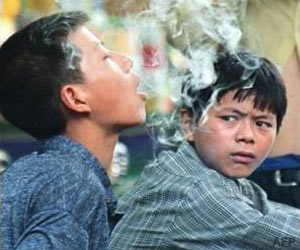Secondhand smoke exposure and heart rhythm disorder risk: Children exposed to secondhand smoke (passive smoking) are at a higher risk for atrial fibrillation (AFib), reveals a new study.

‘Children exposed to secondhand smoke (passive smoking) are more likely to develop atrial fibrillation (AFib).’
Read More..




Atrial fibrillation (AFib), the most common heart rhythm disorder, is expected to affect 16 million Americans by 2050. Cigarette smoking remains one of the top modifiable risk factors for cardiovascular disease, with 14 percent of U.S. adults currently smoking despite public awareness campaigns to reduce smoking. Smoking has been established as a risk factor for atrial fibrillation, with estimates that 7 percent of all AFib can be attributed to smoking.Read More..
Using data from both the original Framingham Heart Study and the Framingham Heart Offspring Studies, the researchers analyzed a total of 5,124 Offspring cohort participants under the age of 18 from 1971 to 2014. Parents were evaluated by a physician every two to four years, and children were evaluated every four to eight years.
Smoking was defined in both studies as participants smoking more than one cigarette daily during the year prior to their study examination. Smoking status was calculated in terms of packs per day, where one pack of cigarettes represented 20 cigarettes and a half pack represented 10 cigarettes. Secondhand smoke exposure was defined as the presence of a parent smoking anything more than zero packs per day.
Participants were considered to have AFib through an assessment of results from medical records, ECGs and Holter monitors. A total of 2,816 (55 percent) of the children in the Offspring cohort had parental smoking status data available. Secondhand smoke exposure was experienced by 82 percent of the children, and parental smoking status averaged at 10 cigarettes per day.
Among the Offspring cohort, 14.3 percent of participants developed AFib over a follow-up period of 40.5 years. For each pack per day increase in parental smoking, children had an 18 percent increase in developing AFib.
Advertisement
The researchers also found that 17 percent of the children of parents who smoke were more likely themselves to smoke, suggesting another way that parental smoking might predispose children to AFib in the long-term. Previous investigations have also confirmed that a smoking parent increases the likelihood of a child's chance of smoking later in life. Smoking cessation by the parents may lead to a decreased smoking incidence for their children.
Advertisement
The study has several limitations, including a lack of available data for parental smoking status in nearly 45 percent of the Offspring participants, as well as variations in parental smoke exposure among children of separated, divorced, single parents or other smoking family members. The demographic makeup of the Framingham Heart Study is a predominantly white cohort in one geographic area. However, the researchers stressed the importance of continued efforts toward smoking cessation and prevention of smoking initiation.
Source-Eurekalert















